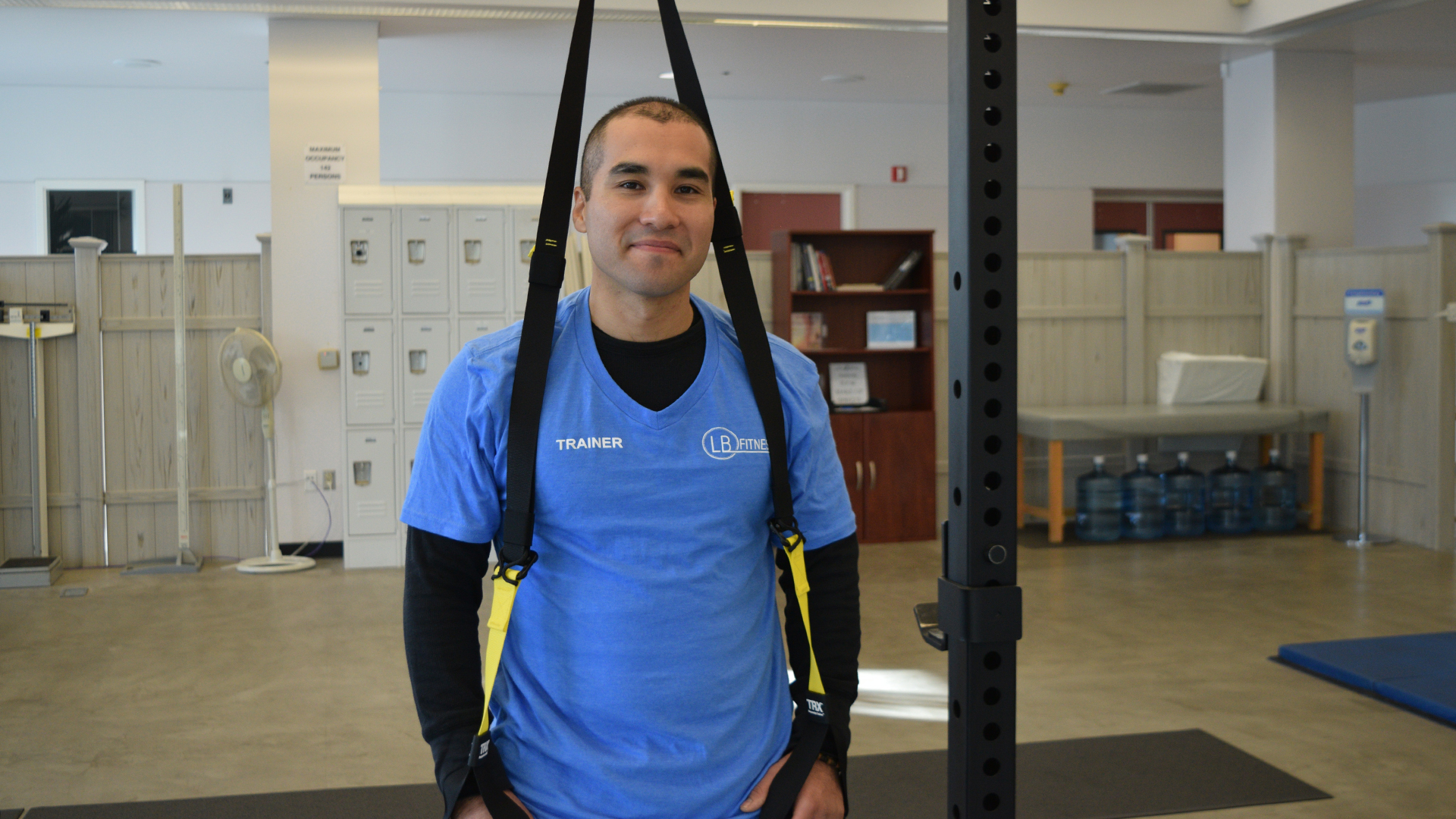
By Larry Kidder | Al Sierra, former trainer for LB Fitness—soon to be Drayson Center Personal Training, has put together a series of stretching exercises designed to wake up every muscle group. Al recently joined the military, where he will train as a physical therapist assistant. In the photo above, he uses TRX bands, a form of resistance and stretch training in which he has a great deal of expertise. Scroll down for photos and examples.
Al Sierra, former personal trainer with LB Fitness—now Drayson Center Personal Training, the team of personal training specialists here at Drayson Center, has given a great deal of thought to stretching—both before and following physical activity.
Recently, he shared some of his insights with me during my personal training sessions. I was interested in ways to stretch and exercise going to and from work, as well as in my office in front of a computer screen. I also wanted to burn more calories and reduce the aches and pains of sitting most of my day.
Sierra, a graduate of California State University-San Bernardino, studied kinesiology (the mechanics of body movement) as his major. Based on his studies and fitness training experience, he has developed a series of warm-up and cool-down stretches to both prepare the body for strenuous exercise and safely cool it down for faster recovery.
“Strenuous exercise should not cause high levels of pain,” Sierra points out. “In fact, pain exceeding a 5 out of 10 suggests harmful muscle or joint damage that far exceeds any exercise benefits.”
Sierra believes that a careful warm-up routine to energize and prepare muscles can be comfortable and effective, concentrating entirely on movement and range of motion. “The saying, ‘No pain, no gain,’ can be potentially harmful,” Sierra argues, “because athletes at all levels can overdue exercise and injure themselves.”
The stretching regimen can be accomplished from a stationary position, providing an ideal way to both energize muscles and burn calories for individuals who seldom, if ever, make it to a gym. In fact, a great deal of stretching can take place on the way to and from the office, as well as during short breaks throughout the workday.
Through stretching and better posture, the aches and pains of office work can be reduced or eliminated entirely, while calorie-burning increases. For instance, sitting at a true 90-degree angle puts maximum pressure on your lower spine, setting you up for pain.
Sierra divides the body into three teams. Team 1 is anything above the diaphragm. Team 2 describes the core—from the diaphragm to the top of the hips. Team 3 refers to the legs, the most active muscles in the body.
“By working on posture and muscle tone, balance and stability are significantly improved,” Sierra details. “Basic stretching can be varied to increase difficulty and challenge the brain. Increasing one’s coordination exercises the brain as well.”
How do the stretching exercises work? You begin your workout as you leave your car and walk to your office. Stand tall and straight as you walk, chest out and stomach in, concentrating on placing your feet down with each step, then propelling forward. You should already feel an active sensation in your legs. Those are calories burning.
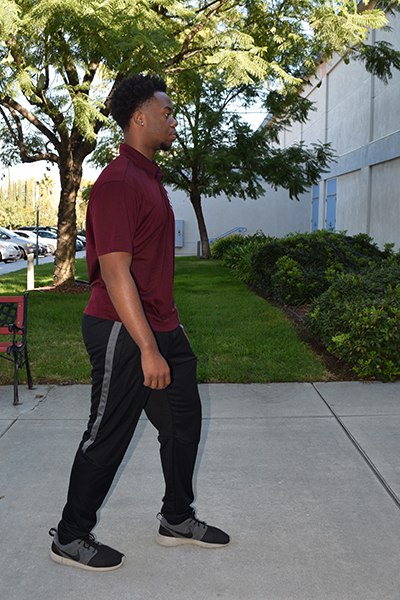
Quinton Hamilton, a marketing assistant and service desk attendant at Drayson Center, demonstrates how to walk, keeping his chest out and stomach in, and pushing off from each foot while maintaining a slight bend in the knee.
If you ever observe the “changing of the guard” at the Tomb of the Unknown Soldier at Arlington Cemetery, or any other national monuments guarded by the U.S. Military, you will notice the way the guards glide as they march—unlike soldiers from other countries. This gliding action reduces stress on the joints, unlike the jarring motion of other “marchers.”
As you climb the stairs to your office (in place of the elevator), vary your steps by placing your heel first on each stair, then pushing off. Alternate with pushing off your toes. Both movements will impact the muscles from your calf to your foot.
As a variation, you can angle slightly to the left or right as you ascend (if you have a large foot, this may be necessary). Calories are burning as your muscles activate. In addition, avoid fully locking your knees as you walk. By keeping them slightly flexed, you burn additional calories and reduce damage to your joints—since locking your knees is part of the body’s natural resting position.
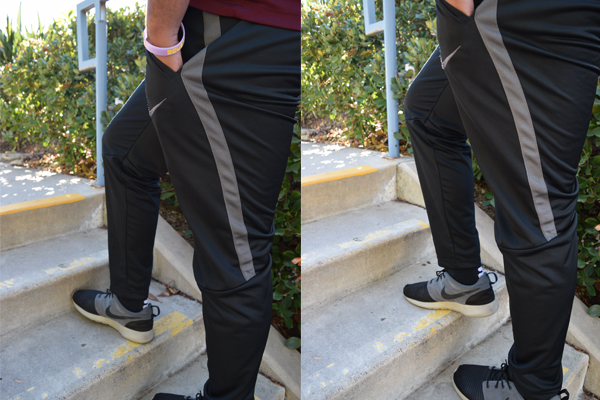
Notice that Quinton is climbing the stairs heel to toe in the the left photo, and toe to heel in the right. By varying step-climbing, multiple sets of leg muscles are used, balancing your warmup. Be sure to lift your legs, then place your feet—rather than kicking forward in your steps, making it less likely that you will trip going up the stairs.
Going down stairs is far more dangerous to your balance and more damaging to your joints. If you are going to ride the elevator, ride it down. If not, turn slightly sideways as you descend the stairs. Keep your knees from fully locking, reducing the direct shock to them. As a variation for your muscles and brain, trying angling the opposite of your natural direction. But be careful! Going down stairs is when you are most likely to stumble.
Once you’re comfortable—or bored—with the exercises above, you can make things more challenging by varying the way you step over or under the stationary leg as you ascend or descend. Remember to avoid locking your knees.
Reaching your office, you probably face a day at your desk, staring at a computer screen, or perhaps sitting around conference tables. To avoid succumbing to the new “smoking,” otherwise known as “sitting disease,” try not to sit stationary for more than 20 minutes at a stretch. Some of the smart watches will remind you to move every so often. Or you can use an electronic calendar on your phone or computer to remind you to move.
You can work on some or all of the following stationary stretches, depending on how much time you have. They can also be accomplished throughout your day.
Team 3: hips and below; hands on hips and feet together; smoothly as possible
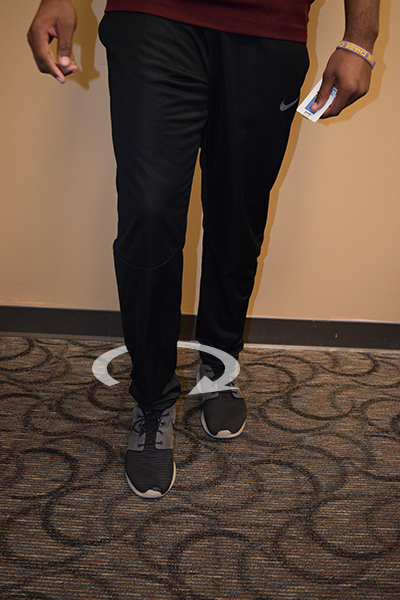
Ankle circles (above). Put your hands on your hips for stability. Keeping your toe in place and rotate your ankles clockwise, then counterclockwise, in sets of 10 rotations.
Calf lifts. Rock from heels to toes, stretching without causing pain.

Knee lifts (above). Bring each knee up as high as you comfortably can and place it back on the floor as smoothly as possible.
Heel kicks. Pretend you are trying to clean some annoying gum off the bottom of your shoe, bringing your heel up as if you are going to kick your back end.
Step-overs. Pretend you are stepping over an object. For variation, circle each leg clockwise, then counterclockwise as you step.
Team 3/Team 2: legs correct for balance, abs control movement from waist
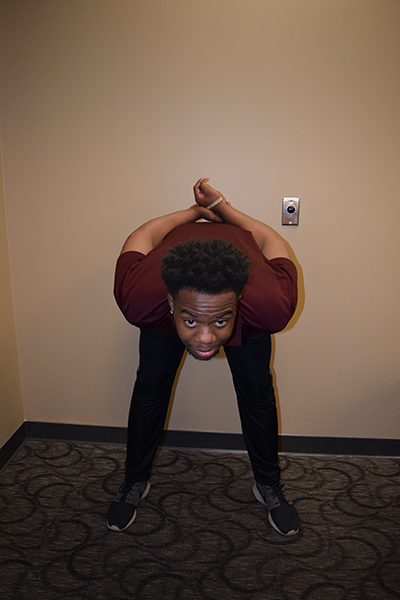
Good mornings (above). Stand “at ease,” hands behind your back and legs apart. Bend forward only at the waist, being careful to slightly push your range of motion without pain. Return to upright. Count to three going down, then three back. Picture bowing to someone, keeping eye contact.
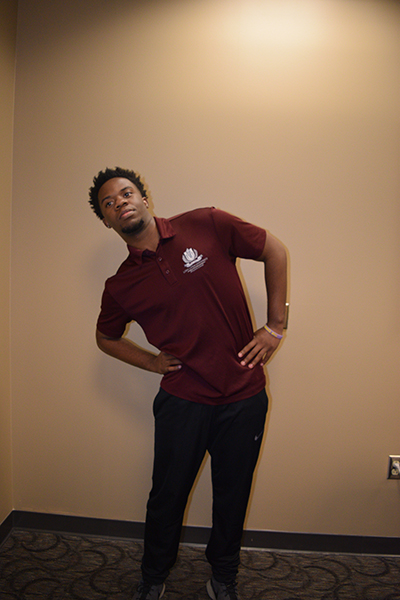
Side bends (above). With hands on chest, bend at the waist to the right and left.
Twists. Rotate from your hips and torso to the right and left. As a variation, rotate in opposite the direction. Think about grass skirts and leis.
Team 1: chest and above
Arm crosses. With palms up, swing your arms out, then in to touch your chest.

High claps (above). Swing your arms from your sides to above your head, clapping at the top (like performers do when trying to get the audience to clap).
March. Swing your arms like you’re marching. You don’t need to actually march, but you can if you have room (combine with knee lifts or heel kicks for a challenge).
.jpg)
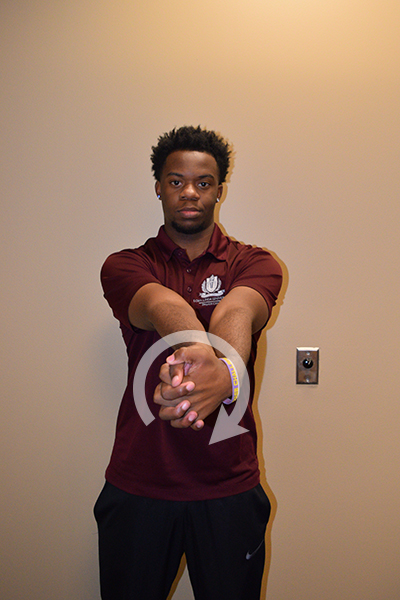
Wrist circles (above). Clasp your hands together, interlocking your fingers. Circle your wrists out, left, in, right. Vary clockwise to counterclockwise. This is a great way to avoid carpal tunnel syndrome.
Shoulder circles. With your hands clasped in front of you, move your shoulders in circles (clockwise, then counterclockwise).
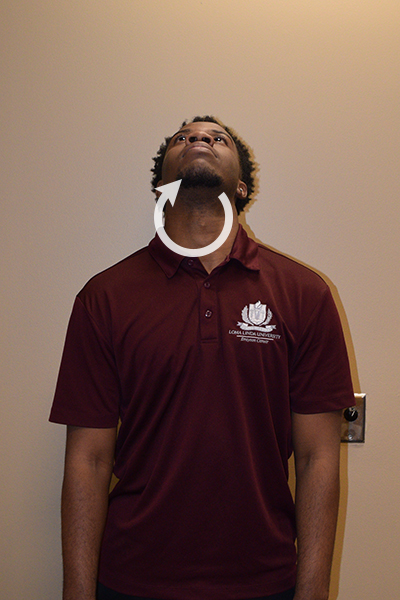
Chin circles (above). Clasp your hands in front. Move your chin in circles (clockwise, counterclockwise).
Clumsy clapping. Stretch your arms out to your sides, then bring them together as if you’re going to clap—but miss, ending with a self-hug.
Now you’re ready for strenuous exercise—or another 20 minutes of work, with warm muscles and free range of motion. You’ve also burned a number of calories as you activated your various muscle groups.
To cool down, simply do static stretches, slightly challenging your range of motion but holding until your muscles relax. This will return them to a resting state, carefully stretching them to avoid cramping and soreness. Do not push yourself to the point of pain—just a slightly uncomfortable stretching sensation and hold.
The excuse, “I can’t make it to the gym,” no longer has power over you. Practice the exercises above throughout your day and you will experience less chronic pain while you burn more calories and combat sitting disease.
